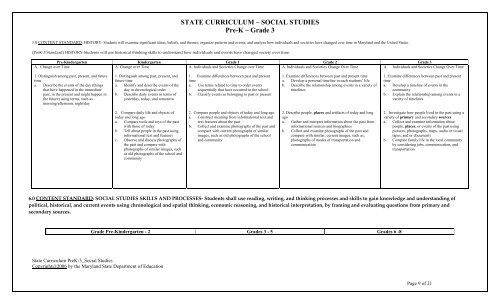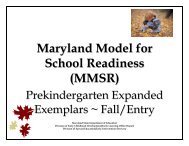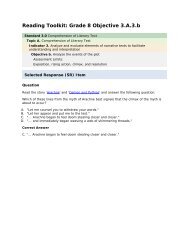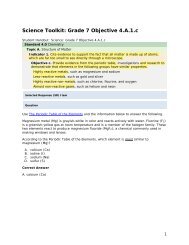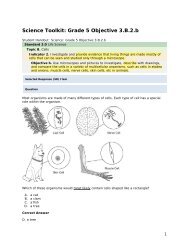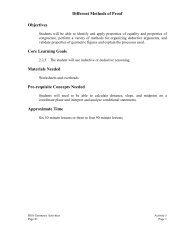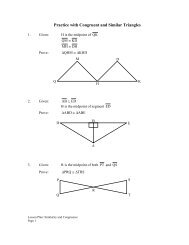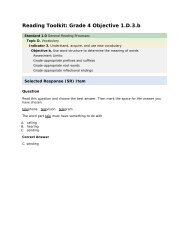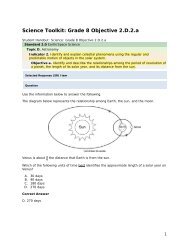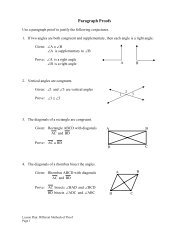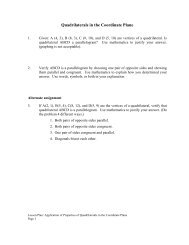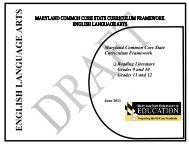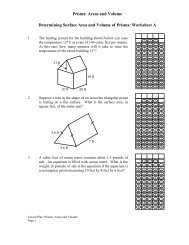Maryland State Curriculum - mdk12
Maryland State Curriculum - mdk12
Maryland State Curriculum - mdk12
- TAGS
- maryland
- curriculum
- mdk12.org
Create successful ePaper yourself
Turn your PDF publications into a flip-book with our unique Google optimized e-Paper software.
<strong>State</strong> <strong>Curriculum</strong> PreK-3_Social Studies<br />
Copyright@2006 by the <strong>Maryland</strong> <strong>State</strong> Department of Education<br />
STATE CURRICULUM – SOCIAL STUDIES<br />
Pre-K – Grade 3<br />
5.0 CONTENT STANDARD: HISTORY: Students will examine significant ideas, beliefs, and themes; organize patterns and events; and analyze how individuals and societies have changed over time in <strong>Maryland</strong> and the United <strong>State</strong>s.<br />
(PreK‐3 Standard) HISTORY‐Students will use historical thinking skills to understand how individuals and events have changed society over time.<br />
Pre-Kindergarten Kindergarten Grade 1 Grade 2 Grade 3<br />
A. Change over Time<br />
A. Change over Time<br />
A. Individuals and Societies Change over Time A. Individuals and Societies Change Over Time<br />
A. Individuals and Societies Change Over Time<br />
1. Distinguish among past, present, and future<br />
time<br />
a. Describe the events of the day (things<br />
that have happened in the immediate<br />
past, in the present and might happen in<br />
the future) using terms, such as<br />
morning/afternoon, night/day<br />
1. Distinguish among past, present, and<br />
future time<br />
a. Identify and describe events of the<br />
day in chronological order<br />
b. Describe daily events in terms of<br />
yesterday, today, and tomorrow<br />
2. Compare daily life and objects of<br />
today and long ago<br />
a. Compare tools and toys of the past<br />
with those of today<br />
b. Tell about people in the past using<br />
informational text and features<br />
c. Observe and discuss photographs of<br />
the past and compare with<br />
photographs of similar images, such<br />
as old photographs of the school and<br />
community<br />
1. Examine differences between past and present<br />
time<br />
a. Use terms related to time to order events<br />
sequentially that have occurred in the school<br />
b. Classify events as belonging to past or present<br />
2. Compare people and objects of today and long ago<br />
a. Construct meaning from informational text and<br />
text features about the past<br />
b. Collect and examine photographs of the past and<br />
compare with current photographs of similar<br />
images, such as old photographs of the school<br />
and community<br />
1. Examine differences between past and present time<br />
a. Develop a personal timeline in each students’ life<br />
b. Describe the relationship among events in a variety of<br />
timelines<br />
2. Describe people, places and artifacts of today and long<br />
ago<br />
a. Gather and interpret information about the past from<br />
informational sources and biographies<br />
b. Collect and examine photographs of the past and<br />
compare with similar, current images, such as,<br />
photographs of modes of transportation and<br />
communication<br />
1. Examine differences between past and present<br />
time<br />
a. Develop a timeline of events in the<br />
community<br />
b. Explain the relationship among events in a<br />
variety of timelines<br />
2. Investigate how people lived in the past using a<br />
variety of primary and secondary sources<br />
a. Collect and examine information about<br />
people, places, or events of the past using<br />
pictures, photographs, maps, audio or visual<br />
tapes, and or documents<br />
b. Compare family life in the local community<br />
by considering jobs, communication, and<br />
transportation<br />
6.0 CONTENT STANDARD: SOCIAL STUDIES SKILLS AND PROCESSES‐ Students shall use reading, writing, and thinking processes and skills to gain knowledge and understanding of<br />
political, historical, and current events using chronological and spatial thinking, economic reasoning, and historical interpretation, by framing and evaluating questions from primary and<br />
secondary sources.<br />
Grade Pre-Kindergarten - 2 Grades 3 - 5 Grades 6 -8<br />
Page 9 of 21


